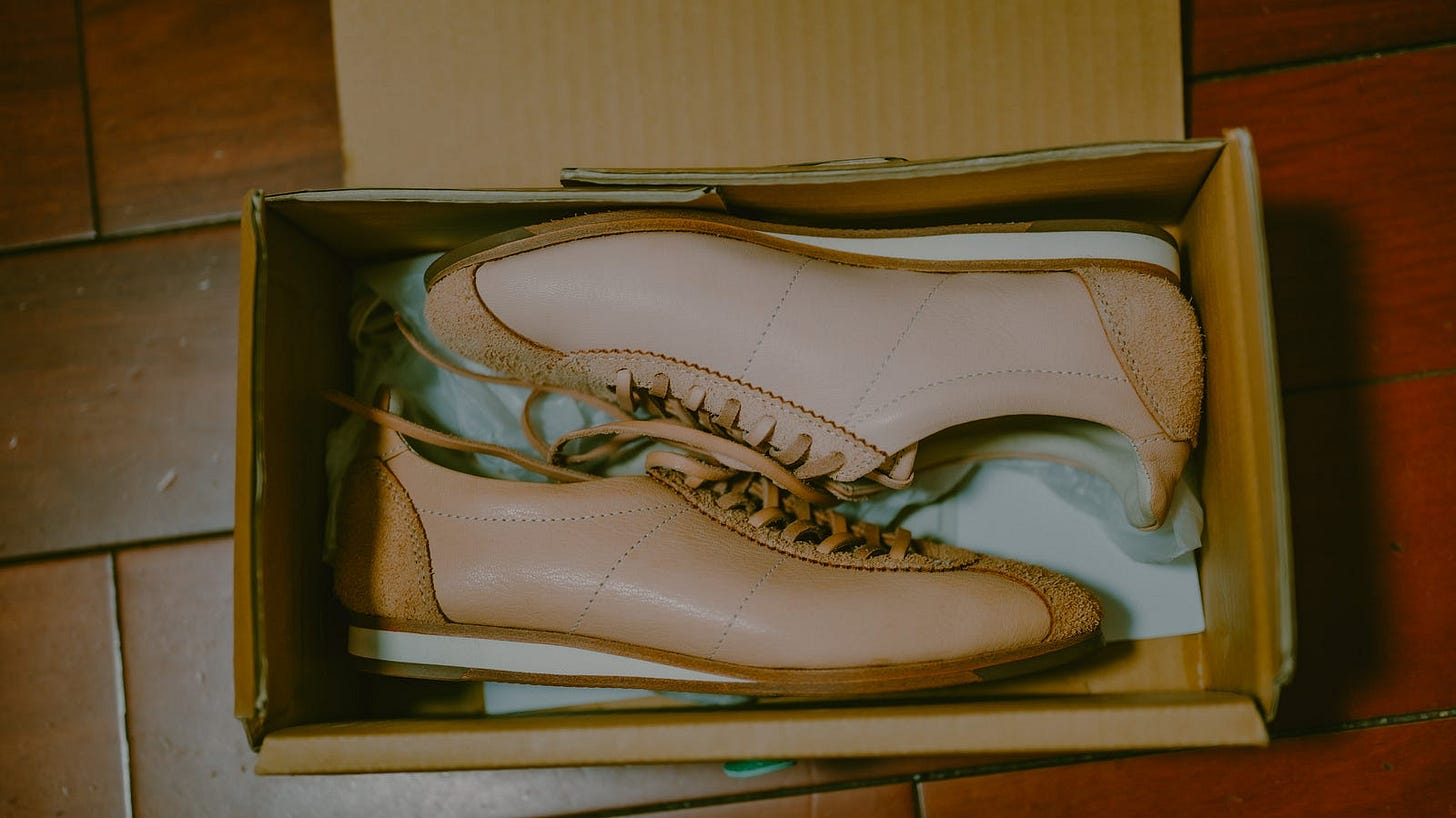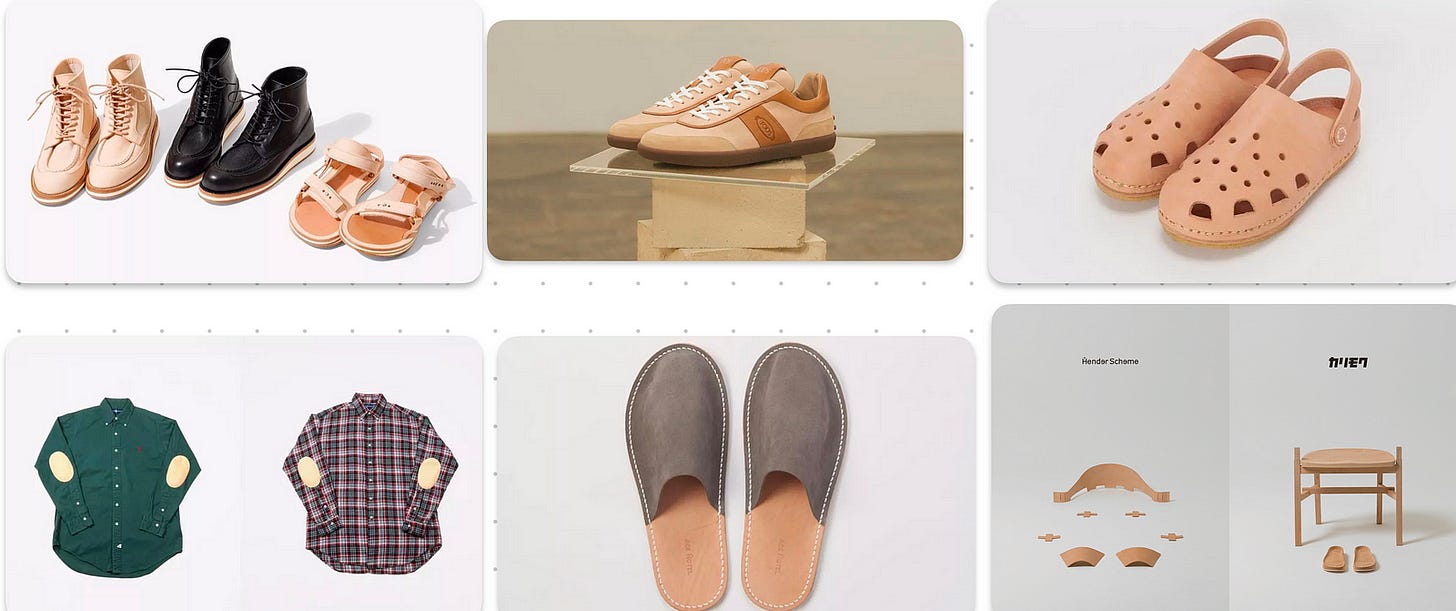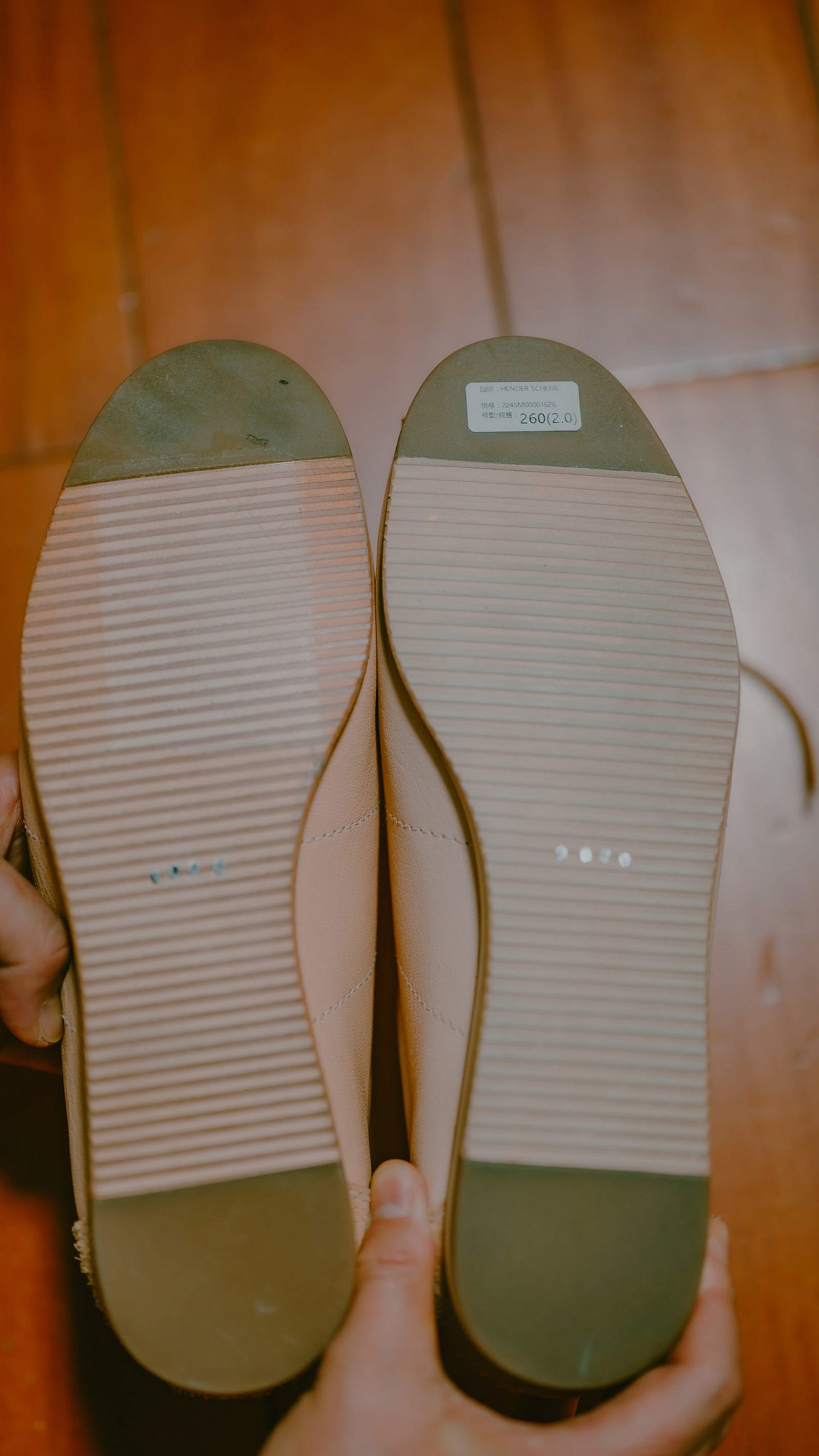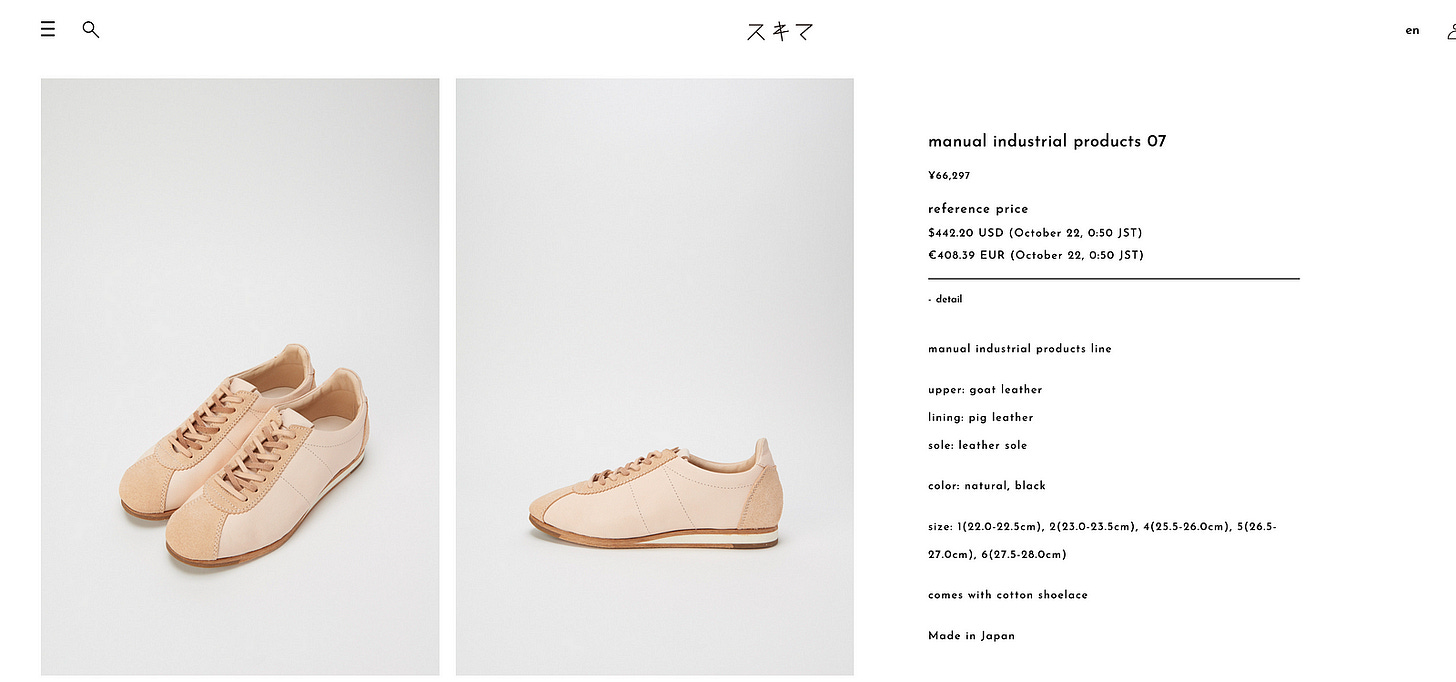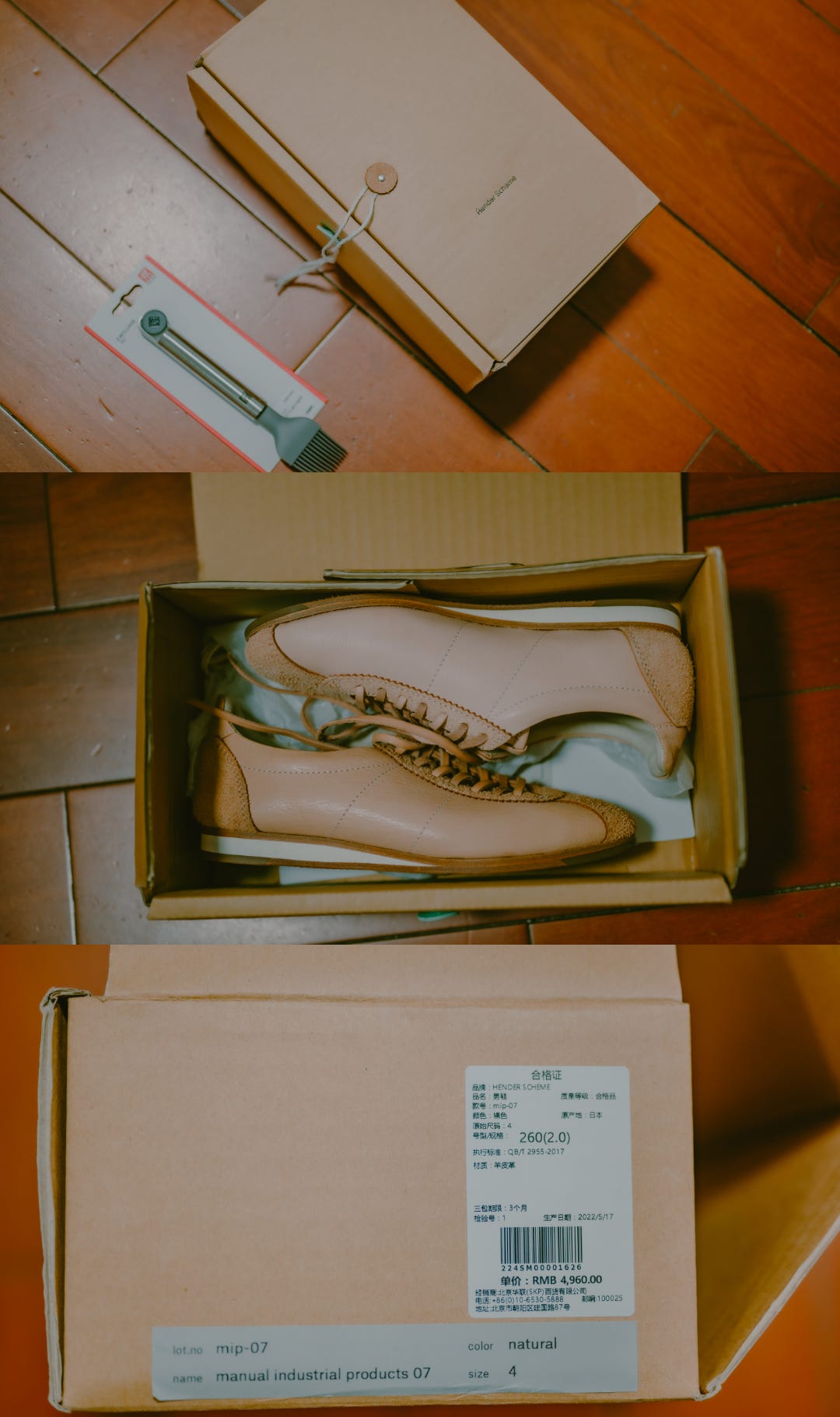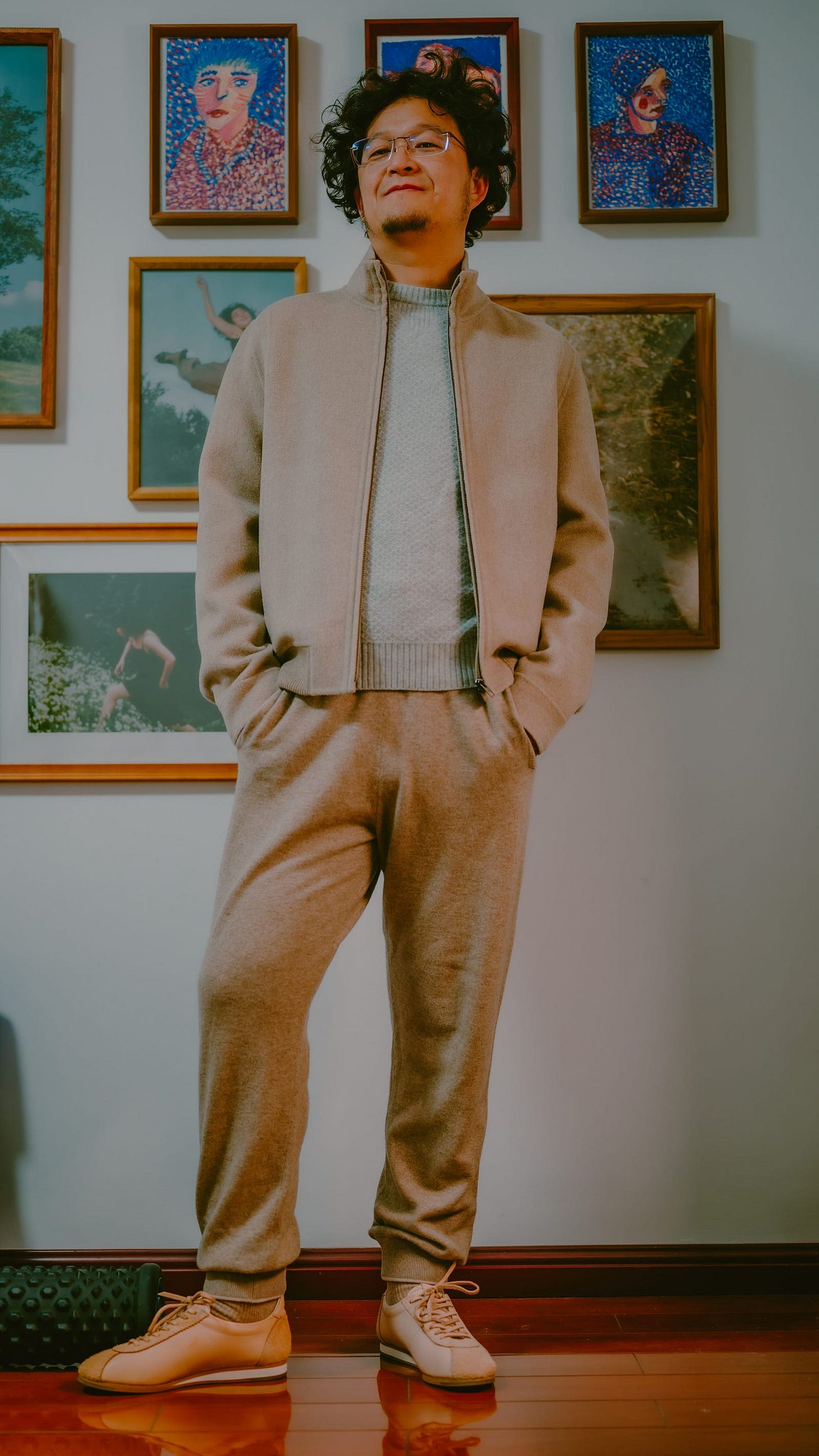Hender Scheme | Handmade Natural Vegetable-Tanned Leather Casual Shoes, Scored a Pair of Bowling Shoes (MIP-07) at 65% Off
Hender Scheme | Handmade Natural Vegetable-Tanned Leather Casual Shoes, Scored a Pair of Bowling Shoes (MIP-07) at 65% Off
I first came across this brand when I was researching German military trainers. Since all I saw were listings on Taobao, and there were no official flagship stores or channels, I only briefly looked into it and moved on. But unexpectedly, during a random shopping trip, I encountered this brand again at SKP-Select. Their product selection was full of surprises. I tried on a pair and found the shoe shape, cost-performance ratio, and leather texture to be quite impressive, so I decided to buy them.
Even though it’s a unisex model, the men’s version sells better, as the brand originally gained fame for making handcrafted vegetable-tanned leather sneakers. Most stores stock more men’s shoes, and I haven’t seen anyone buying the women’s version yet.
This post introduces the Hender Scheme brand’s background and the MIP-07 bowling shoe from their core series, Manual Industrial Products (MIP), that I just bought.
Hender Scheme
Ryo Kashiwazaki, like most kids born in the ’90s in Japan, developed an interest in fashion during his childhood through soccer, wearing cleats, and matching uniforms. In his teenage years, he discovered music in Machida, shopped in second-hand stores, and fell in love with vintage clothing. His grandmother, a seamstress, and his mother, who worked at Isetan, subtly influenced his growing interest in fashion.
A few years later, Ryo started working in a footwear studio in Asakusa, a district once known as one of Tokyo’s main leather exporters during the Edo period. At the age of 19, Ryo split his time between working at the studio and learning the craft. He developed a deep love for leather, particularly in its raw and unrefined state. In 2010, he left the studio and founded Hender Scheme, aiming to connect with users through his designs (holding workshops to interact with customers, not just through sales channels), while also providing more work for Asakusa’s artisans and factories.
Founded in 2010, Hender Scheme opened its first flagship store, sukima Ebisu, six years later. Located in the Ebisu district of Shibuya, Tokyo, the store was converted from a 50-year-old car parts factory. It features natural leather products, wooden displays, and weathered industrial walls, wires, and old doors, creating a surprisingly harmonious blend of raw materials and industrial aesthetics.
By the way, Ebisu is a great spot for homeware boutiques and craft beer bars, definitely a place worth visiting if you’re traveling to Tokyo.
Aside from the Ebisu store, Hender Scheme has opened additional sukima stores in Kappabashi and Miyashita Park, and there’s also a sukima Osaka store. However, these physical stores are currently only in Japan, with distributors handling sales in Europe, the U.S., and China.
In mainland China, Hender Scheme is distributed by SKP-S. Due to its sporty nature, it’s also available at fashion retailers like I.T. and Alumni Chengdu. There’s even a Taobao store called “The Midnight Club,” which I found through a link on Hender Scheme’s official site. If you’re into Japanese leather jackets, shoes, or accessories (mainly men’s fashion), it’s worth checking out — they have many high-quality brand collaborations.Of Course if you’re living in China mainland.
Ryo Kashiwazaki enjoys watching leather naturally darken and age, much like the raw industrial aesthetics of his store design. You can see in this pair of bowling shoes that the two shoes are slightly different in color. The new pair starts out as a shiny, pale pink, but within a few weeks of exposure to light, one shoe turns yellow.
Initially, Hender Scheme’s Manual Industrial Products (MIP) series was criticized for copying the designs of brands like New Balance, Puma, Adidas, and Nike. While the silhouettes were similar, Hender Scheme stood out by using their own handcrafted techniques and vegetable-tanned leather. In recent years, even Adidas and Nike have officially recognized Hender Scheme’s designs, leading to official collaborations.
Some might say it was a successful case of “copying,” but in fashion, design is only one element. Other factors, such as materials, tailoring details, modifications to the silhouette, color customization, and even capital collaborations, all play a role. Many imitators fail to surpass the original designs, but Hender Scheme managed to do so, solidifying its position in the market.
Due to its roots in recreating popular silhouettes with its own craftsmanship, Hender Scheme has begun collaborating with more brands. They’ve worked with Sacai on men’s sandals and boots, Tods on shoes, Crocs on clogs, Ralph Lauren on leather elbow patches for shirts, and Ace Hotel on slippers. They even partnered with Japanese wooden furniture experts Karimoku.
Although Ryo Kashiwazaki is best known for making shoes and initially built his reputation in that field, the brand now uses its handcrafted vegetable-tanned leather techniques for various small goods, including book covers, cardholders, wallets, storage boxes, pen cases, watch straps, phone cases, and even plant pots.
MIP-07 Bowling Shoes
The pair I bought is the MIP-07. The smooth part of the upper is made of goatskin, the suede is cowhide, and the inner lining is pigskin (which I’m not too happy about, as goatskin would’ve been softer but more prone to wear). The middle part of the sole is leather, while the toe and heel areas are rubber. Since these are bowling shoes, the soles need to provide both grip and slide. Imagine yourself bowling: gliding effortlessly across the slick floor of the bowling alley, with enough traction to maintain steady steps but also enough slide to move smoothly.
At the Swiss boutique Tempo Design Store, these shoes are priced at $651, around ¥4600.
However, during Black Friday on Hender Scheme’s official website, they were priced at $442, around ¥3100.
At SKP-S, the full price for these MIP-07 shoes was also around ¥4600, but I got them for around ¥1600 with a 65% discount. Plus, there was only one pair left in size 40, which had yellowed slightly after sitting out for two weeks. Overall, it was a great deal!
Aside from the MIP-07, SKP-Select Outlet also had another pair on sale (the one on the far right in the image below). I didn’t try those since they were more of a sports shoe style. Recently, Hender Scheme’s best-sellers in China have been their designs that resemble German military trainers, like the pair on the far left.
This pair’s value rivals a pair of Common Projects I snagged at Lane Crawford before. They are just as well-made, if not better, than Onitsuka Tiger’s Japanese-made shoes. From now on, I think I’ll skip Onitsuka Tiger and stick to Hender Scheme’s handmade shoes.
Compared to the pink Common Projects Achilles, the new Hender Scheme leather is also a bright pink. The silhouette is narrower and sleeker, perfect for slim feet.
These pink shoes pair well with winter colors like purple or teal. The jacket is from ICICLE, found during a mid-autumn sale at their factory store, and now it’s even further discounted, though my size is sold out. The cashmere pants are also from ICICLE, purchased with vouchers during the anniversary sale at Badaling Outlets.
Lastly, here’s a quick lesson on vegetable-tanned leather and why Hender Scheme’s leather has that iconic pink tone.
Vegetable-Tanned Leather: Tanned using natural substances like tannins from tree bark or fruits, this leather is more expensive, stiffer, and more durable. Over time, it oxidizes naturally, changing from light yellow to an amber hue, showcasing a beautiful natural patina. It’s highly prized for high-end leather goods. However, it is more sensitive to water, even more so than chrome-tanned leather, so it’s best to avoid wearing it in the rain. Instead of washing, use a special cleaner for vegetable-tanned leather, and for the suede parts, a regular eraser works well.
Chrome-Tanned Leather: Tanned using chromium salts, this method is the most common in modern leather production. It’s much faster, taking only days compared to the months required for vegetable-tanning. Chrome-tanned leather is softer and more water-resistant. However, it’s less environmentally friendly and doesn’t last as long as vegetable-tanned leather, often used for lower-end leather products.
Aldehyde-Tanned Leather: Tanned using aldehydes, this leather is often used for baby products or hypoallergenic leather in hospitals.
Synthetic-Tanned Leather: Tanned using synthetic chemicals, this type is typically used for specialized performance leathers.
Postscript
Now, he enjoys dressing up as much as I do, picking out nice clothes and trying on different outfits in front of the mirror — sometimes changing 3 or 4 times a day! He also loves shopping and helps me check out sales events when I’m too busy.
The anniversary sales at Badaling Outlets didn’t disappoint — lots of people, but great deals. I’ve already saved ¥2000 on Singles’ Day; let’s see how the rest of the purchases turn out!








